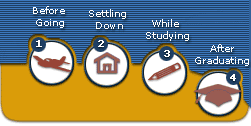|
In America, the costs of medical treatment are quite high while
the government does not provide much support. To ensure that
you will be able to support your medical expenses while studying
in the U.S., universities usually require international students
to purchase or present proof of health insurance before enrolling
in the class.
This might be quite different from the situations in countries
where many international students came from. In Germany and Taiwan,
for example, the government pays for basic medical expenses and thus,
its people don't have to worry about health insurance. On the other
hand, in Thailand, medical expenses are more affordable due to
certain government regulations and subsidies. Consequently, most
Thais do not have any health insurance.
Since you probably never had health insurance before coming to the
U.S., let's spend the next 5 minutes to learn the basics about health
insurance.
Don't avoid it!
Health insurance helps you insure yourself against the risk of financial
damage as a result of you or your family member getting sick or injured.
Many international students, due to the fact that they are never required
to have health insurance in their country, think that it's a waste of
money to purchase an expensive policy. However, medical expenses in
America are really high and they can catch you by surprise. You can be
charged for a few thousand dollars for common sickness and injuries
like broken leg or appendicitis operation. Moreover, hospitals and
doctors may refuse to treat you if you don't have proof of insurance.
Carry the card!
Once you purchase the policy, the insurance company will issue you a
card that you should carry with you all the time. In case you get
sick, show this card to the nurse or staff at the physician's office.
Remember, many hospitals and doctors will not accept a patient without
proof of health insurance.
Know the answers!
The staff at the hospital will usually ask you whether you have visited
there before. If not, you will be required to fill out a form, which
contains questions regarding your insurance information, like the name
of the insurance carrier and the policy number. Also, they may ask the
following questions regarding your policy. So, make sure that you know
the answers.
- What is your deductible, (or co-pay)?
Generally, there are two types of deductible. The first one is a
per-sickness deductible. You have to pay a fixed amount for each
injury or sickness. This means if you go back to the doctor for
the same sickness, you do not need to pay the deductible again. The
second type is a per-policy deductible. Let's say you have a per-policy
deductible of $100. If you visit the doctor in the beginning of the
year and it costs you $150, you will have to pay $100 for deductible
and the other $50 will be paid by your insurance provider.
From then on, no matter how many times you visit a doctor, you are
not required to pay for deductible again until the policy expires.
Most insurance plans for international students are Traditional
Major Medical plans. To be sure, please confirm with your provider.
Click here
for the definition of each type of health insurance.
Seeing the doctor
Some insurance policies may require your doctor to fill out a claim
form about the nature of your sickness. So, don't forget to
bring the form with you.
In addition, your policy may not cover certain medical treatments
like MRI or Chiropractic treatment. Therefore, before getting the
treatment from the doctor, make sure that it is covered by your plan
or check with the insurance carrier first.
Paying the bill
After you are treated, you still have to pay for seeing the doctor.
Depending on your policy, you may be required to either 1) pay only
the deductible while the doctor will bill the rest of the charges to
your insurance, or 2) pay the full amount and claim them back later
from your insurance company.
If your policy allows you to pay only deductible, the insurance
company, a few weeks later, will send you a form to be filled so
that they can verify the treatment information with you.
If you had to pay the full amount, make sure that you collect
the receipts and write down all the related information about your
sickness/injury so that you can fill out the claim form.
|









 |
|  Tips & Advices on Health Insurance
Tips & Advices on Health Insurance